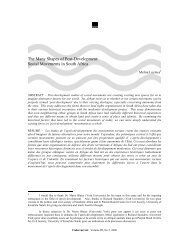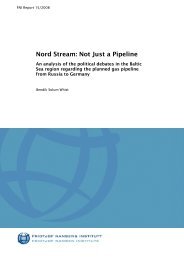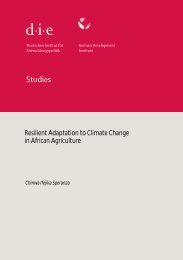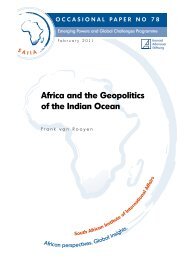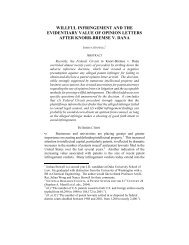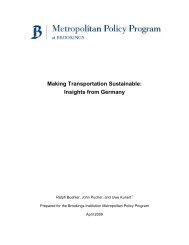equity implications of health sector user fees in tanzania
equity implications of health sector user fees in tanzania
equity implications of health sector user fees in tanzania
Create successful ePaper yourself
Turn your PDF publications into a flip-book with our unique Google optimized e-Paper software.
diseases, (3) reduc<strong>in</strong>g malnutrition and (4) achiev<strong>in</strong>g a drastic reduction <strong>of</strong> <strong>in</strong>come poverty (Human<br />
Development Report 2002:34 and Poverty and Human Development Report 2002:105). Tanzania has<br />
also committed itself to achiev<strong>in</strong>g the Millennium Development Goals (MDGs). It is foreseen, however,<br />
that the worry<strong>in</strong>g <strong>health</strong> trends will also negatively affect the achievement <strong>of</strong> the <strong>health</strong> related MDGs<br />
number 4, 5 and 6 (see annex 5).<br />
3.3 The position <strong>of</strong> <strong>health</strong> <strong>in</strong> the PRSP<br />
Health addressed <strong>in</strong> the PRSP<br />
The study team analysed key <strong>health</strong> related issues <strong>in</strong> the Tanzanian PRSP by mak<strong>in</strong>g use <strong>of</strong> a selfdesigned<br />
assessment tool (Annex 4; based on Laterveer et al, 2003) and an analysis carried out by<br />
the Word Health Organisation (WHO 2003). Table 3.4 presents the outcomes <strong>of</strong> these analyses.<br />
Table 3.4: Health as addressed by the PRSP <strong>of</strong> Tanzania<br />
1. Health is an important component <strong>of</strong> the Tanzanian PRSP. The paper identifies ‘disease’ as one <strong>of</strong> the three<br />
national ‘development problems’. It recognizes the particular role <strong>of</strong> <strong>health</strong> <strong>in</strong> the context <strong>of</strong> poverty reduction,<br />
by identify<strong>in</strong>g it as one <strong>of</strong> the priority <strong>sector</strong>s for improv<strong>in</strong>g human capabilities, survival and social well-be<strong>in</strong>g.<br />
2. The <strong>health</strong> <strong>sector</strong> strategy proposed by the PRSP is rather disease-oriented, with less attention for exam<strong>in</strong><strong>in</strong>g<br />
or address<strong>in</strong>g underly<strong>in</strong>g <strong>health</strong> system weaknesses. The focus is ma<strong>in</strong>ly on reduc<strong>in</strong>g <strong>in</strong>fant and child<br />
mortality rates and the burden <strong>of</strong> communicable diseases, especially HIV/AIDS and malaria. Improv<strong>in</strong>g <strong>health</strong><br />
services provision, especially primary <strong>health</strong> care, and boost<strong>in</strong>g <strong>health</strong> awareness, particularly on nutrition<br />
and HIV/AIDS, are also mentioned. This <strong>in</strong>dicates an implicit pro-poor approach. However, the difficulties <strong>of</strong><br />
achiev<strong>in</strong>g the set targets <strong>in</strong> the poorest areas and groups are not discussed.<br />
3. The PRSP and the progress reports <strong>in</strong>dicate a lack <strong>of</strong> poverty-related <strong>health</strong> data, despite the commendable<br />
efforts <strong>of</strong> the government to obta<strong>in</strong> such <strong>in</strong>formation. Studies to analyze and describe the distribution <strong>of</strong> the<br />
burden <strong>of</strong> disease across the population, the prevail<strong>in</strong>g <strong>health</strong> system constra<strong>in</strong>ts and the impact <strong>of</strong> <strong>health</strong><br />
services, particularly <strong>in</strong> relation to the poor, are not mentioned. The focus is ma<strong>in</strong>ly on the general population.<br />
4. The PRSP does <strong>in</strong>clude a number <strong>of</strong> specific concerns expressed by the poor: (1) limited access to quality<br />
<strong>health</strong> services, caus<strong>in</strong>g (deeper) poverty, (2) the unsatisfactory level <strong>of</strong> service provision, especially <strong>in</strong> the<br />
rural (poorest) areas, and (3) their limited <strong>in</strong>volvement <strong>in</strong> design<strong>in</strong>g <strong>health</strong> plans and programs. Poor people<br />
also expressed their concern about the low standard <strong>of</strong> <strong>health</strong> education. The PRSP acknowledges only<br />
some <strong>of</strong> the raised concerns, notably the poor condition <strong>of</strong> <strong>health</strong> facilities and the low quality <strong>of</strong> services.<br />
5. Reduc<strong>in</strong>g vulnerability is part <strong>of</strong> both the PRSP and progress reports. Accord<strong>in</strong>g to the PRSP, ‘many<br />
communities are forced to deal with a grow<strong>in</strong>g number <strong>of</strong> AIDS victims and orphans, the handicapped, the<br />
very old and refugees, and there is a grow<strong>in</strong>g need for safety-nets’. The PRSP and progress reports do not<br />
explicitly address the position <strong>of</strong> women (gender), the disabled, and/or HIV/AIDS clients <strong>in</strong> relation to <strong>health</strong>.<br />
Address<strong>in</strong>g extreme vulnerability is said to be a part <strong>of</strong> future poverty reduction policies.<br />
Analysis based on Tanzanian PRSP and PRSP related documents<br />
F<strong>in</strong>ancial barriers to <strong>health</strong> for the poor addressed <strong>in</strong> the PRSP?<br />
The study team also assessed what is stated on cost-shar<strong>in</strong>g, <strong>user</strong> <strong>fees</strong> and the impact <strong>of</strong> <strong>user</strong> <strong>fees</strong> <strong>in</strong><br />
the PRSP and the progress reports. The key f<strong>in</strong>d<strong>in</strong>gs are presented <strong>in</strong> Table 3.5.<br />
Table 3.5: To what extent are f<strong>in</strong>ancial barriers to <strong>health</strong> addressed <strong>in</strong> the PRSP?<br />
1. The PRSP states the commitment to <strong>in</strong>crease <strong>health</strong> spend<strong>in</strong>g.<br />
2. The PRSP does not explicitly mention cost-shar<strong>in</strong>g or <strong>user</strong> <strong>fees</strong> <strong>in</strong> relation to <strong>health</strong>, while do<strong>in</strong>g so<br />
extensively for education (i.e. it announces the abolition <strong>of</strong> <strong>user</strong> <strong>fees</strong>) The rationale for different <strong>user</strong> <strong>fees</strong><br />
strategies for the education and <strong>health</strong> <strong>sector</strong>s is not expla<strong>in</strong>ed.<br />
3. The progress (01/02) report does explicitly address cost-shar<strong>in</strong>g. It reports the <strong>in</strong>troduction <strong>of</strong> the Drug<br />
Revolv<strong>in</strong>g Fund (DRF) <strong>in</strong> all district hospitals; the <strong>in</strong>troduction <strong>of</strong> Community Health Funds (CHF) <strong>in</strong> nearly 40<br />
districts; and the operational National Health Insurance Fund (NHIF) enroll<strong>in</strong>g all civil servants.<br />
4. The progress report concludes that ‘the <strong>in</strong>troduction <strong>of</strong> <strong>health</strong> care f<strong>in</strong>anc<strong>in</strong>g options <strong>in</strong>clud<strong>in</strong>g CHF and <strong>user</strong><br />
<strong>fees</strong> have improved availability, access, provision and use <strong>of</strong> services by beneficiaries as drugs are now<br />
available <strong>in</strong> <strong>health</strong> facilities all the time.’ The report does not expla<strong>in</strong> the policy rationale for the cont<strong>in</strong>uation<br />
and/or further <strong>in</strong>troduction <strong>of</strong> <strong>user</strong> <strong>fees</strong> <strong>in</strong> the <strong>health</strong> <strong>sector</strong>. Neither does it dist<strong>in</strong>ct between <strong>user</strong> <strong>fees</strong> for<br />
public and private services, nor expla<strong>in</strong>s at what service levels <strong>user</strong> <strong>fees</strong> are charged.<br />
5. The PRSP and the progress reports do not discuss f<strong>in</strong>ancial and non-f<strong>in</strong>ancial barriers for the poor to access<br />
<strong>health</strong> services; or exam<strong>in</strong>e which specific groups do not have access. They do not propose measures to<br />
protect the poor aga<strong>in</strong>st possible adverse impacts <strong>of</strong> <strong>user</strong> <strong>fees</strong>, such as exclusion, or reduced (f<strong>in</strong>ancial or<br />
geographical) access or use (i.e. <strong>equity</strong>, which is not mentioned <strong>in</strong> the documents). They do not mention<br />
waiver and exemption schemes or pay attention to implement<strong>in</strong>g or strengthen<strong>in</strong>g exist<strong>in</strong>g schemes. They do<br />
not report on the impact <strong>of</strong> <strong>user</strong> <strong>fees</strong> <strong>in</strong> the <strong>health</strong> <strong>sector</strong> (other than for drugs), <strong>in</strong> general or <strong>in</strong> relation to the<br />
poor. The same can be said for the CHF.<br />
Analysis based on Tanzanian PRSP and PRSP related documents<br />
Equity Implications <strong>of</strong> Health Sector User Fees <strong>in</strong> Tanzania 11






